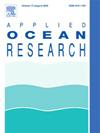Prediction of thrust bearing parameters in shafting-shell coupling system from frequency response function with artificial neural networks
IF 4.3
2区 工程技术
Q1 ENGINEERING, OCEAN
引用次数: 0
Abstract
The thrust bearing is a critical component for power transmission and vibration coupling between the propulsion shafting and the shell of the underwater vehicle. Identifying thrust bearing parameters is crucial for studying the vibration and diagnosing bearing faults of the underwater vehicle. In this study, key information was extracted from the frequency response function (FRF) of the shafting-shell coupling system, and then the artificial neural network (ANN) was used to predict the stiffness and damping of the thrust bearing. The dataset used to train the ANN came from the analytical dynamic model of the shafting-shell system. This analytical approach offers high computational efficiency, making it feasible to generate a substantial amount of training data within a reasonable timeframe. In the analytical dynamic model, the shell was modeled using the Flügge theory, while the shafting system was modeled using the Euler-Bernoulli beam theory. The bearings were simplified as a spring-damping system to represent the connection between the shafting system and the shell. This study employed two ANN algorithms: Backpropagation Neural Network (BP) and Genetic Algorithm-optimized Backpropagation Neural Network (GABP). The results indicate that both BP and GABP effectively predict the stiffness and damping of thrust bearings. Moreover, GABP demonstrates more stable prediction results with smaller prediction errors. The proposed method for predicting thrust bearing parameters leverages features from the FRF to train the ANN, which provides good robustness, maintaining effective results even when the signal-to-noise ratio of the FRF is reduced. The thrust bearing parameter prediction model was validated through experiment, confirming the effectiveness of using ANNs to predict bearing parameters in shafting-shell coupling systems from FRF. This study realizes efficient prediction of bearing parameters, providing a reference for vibration reduction, operational state monitoring, and fault diagnosis of underwater vehicles.
基于频响函数的轴壳耦合系统推力轴承参数人工神经网络预测
推力轴承是水下航行器推进轴与壳体之间动力传递和振动耦合的关键部件。推力轴承参数的识别对于水下航行器的振动研究和轴承故障诊断至关重要。从轴壳耦合系统的频响函数(FRF)中提取关键信息,利用人工神经网络(ANN)对推力轴承的刚度和阻尼进行预测。用于训练人工神经网络的数据来源于轴壳系统的解析动力学模型。这种分析方法提供了很高的计算效率,使得在合理的时间范围内生成大量的训练数据成为可能。在解析动力学模型中,壳体采用fl gge理论建模,轴系采用欧拉-伯努利梁理论建模。将轴承简化为一个弹簧阻尼系统,以表示轴系与壳体之间的连接。本研究采用两种人工神经网络算法:反向传播神经网络(BP)和遗传算法优化反向传播神经网络(GABP)。结果表明,BP和GABP都能有效地预测推力轴承的刚度和阻尼。此外,GABP预测结果更稳定,预测误差更小。所提出的推力轴承参数预测方法利用频响函数的特征来训练人工神经网络,具有良好的鲁棒性,即使在降低频响函数的信噪比时也能保持有效的结果。通过实验验证了推力轴承参数预测模型,验证了利用人工神经网络从频响预测轴壳耦合系统轴承参数的有效性。该研究实现了轴承参数的高效预测,为水下航行器的减振、运行状态监测和故障诊断提供参考。
本文章由计算机程序翻译,如有差异,请以英文原文为准。
求助全文
约1分钟内获得全文
求助全文
来源期刊

Applied Ocean Research
地学-工程:大洋
CiteScore
8.70
自引率
7.00%
发文量
316
审稿时长
59 days
期刊介绍:
The aim of Applied Ocean Research is to encourage the submission of papers that advance the state of knowledge in a range of topics relevant to ocean engineering.
 求助内容:
求助内容: 应助结果提醒方式:
应助结果提醒方式:


